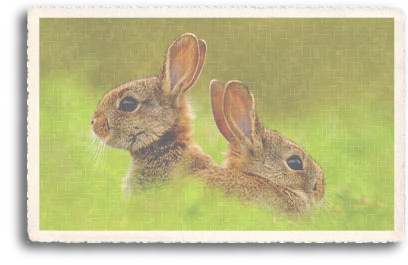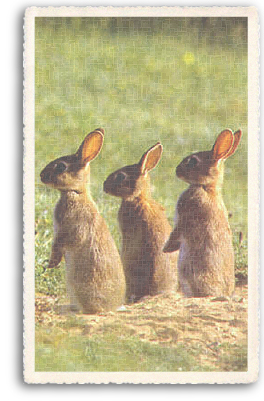 |
||
 Desert Cottontail Rabbit Desert Cottontail RabbitThe Desert Cottontails are medium sized rabbits that are a buff-brown color, lined with a blackish color above and white color below. They have long ears and fluffy tails that look like cotton balls. In length the Desert Cottontail is 13 to 17 inches long and the ears measure 3 to 4 inches. On average they weigh 2 to 3 pounds. Their hind feet are slender and relatively short. Desert Cottontails are common from California to the western half of Texas, north to eastern Montana, and to the midwest up to North Dakota. These mammals adapt to a variety of habitats, from grasslands to deserts. They prefer brushy areas that include pre-established burrows. Cottontails are herbivores. They eat a wide variety of plants including grasses, shrubs, and cacti. Ninety per cent of their diet is grass. Cottontails will forage on domestic crops, even the bark of fruit trees. They get most of their water from either the plants they eat or the dew that forms on the plants.  Cottontails are also coprophagic, meaning they eat their own feces. They deposit two kinds of fecal pellets. The brown hard pellets are formed from digestive plant materials, and the soft green pellets are only partially digested materials. The Cottontail must re-digest these soft pellets to get the full nutritional value from their food. Cottontails are most active during evening time hours and throughout the night. Their activity varies throughout the day. Unlike other rabbits, they sometimes climb sloping trees and prickly shrubs to avoid predators. The Cottontail seeks safety in thickets and abandoned burrows of other animals. They do not dig their own burrows. The Cottontail may thump the ground with its hind foot as a warning to others of potential danger; it may also use its tail by raising it. These rabbits are preyed upon by animals such as the bald and golden eagles, rattlesnakes, foxes, coyotes, and bobcats. When alarmed, a cottontail can run up to 20 mph in a zig-zag pattern to escape from its predators. Sometimes the Cottontail will freeze when danger occurs and scrunch down to blend into its surroundings. Desert Cottontails are born in nests lined with grass and fur that the mothers pull from their stomachs. The nests are located in abandoned burrows, prairie dog burrows, or under shrubs. A female Cottontail may bear young all year long. The gestation period is 25 to 35 days. Two to six blind, helpless, furless young are born. The young Cottontail’s eyes are open in about four to five days and after 14 to 15 days the young may leave the nest. The female will mate again as soon as her litter becomes independent. Black-tailed Jack Rabbit The Jackalope Back to Plants & Wildlife |
||
Home | Food | Lodging | Merchants | Services | Real Estate | Art & Galleries | Entertainment | Recreation Ski Areas | Mind-Body-Spirit | Taos Information | Local Color | Taos Pueblo | High Road to Taos | Taos Plaza | Ranchos de Taos Scenic Beauty | Day Trips | Chili | Special Events | Taos History | Multicultures | Museums | The Enchanted Circle The Wild West | Taos Art Colony | Plants & Wildlife | Counterculture | Turquoise | Architecture | Features | About Us | Get Listed! Taos Unlimited Trading Post | Photo of the Week | Link of the Month | Taos Webcams | Taos Weather | Testimonials | Guestbook Taos A to Z | Movie Locations | Sitemap | Taos Unlimited Blog | Aimee & Jean's Story Blog | Contact Us | Santa Fe Unlimited |
||